A Famous Photographer Visits Southeast Alaska
A century and half ago, Muybridge took the first photos of Alaska.
By DAVE KIFFER
November 23, 2019
Saturday PM
(SitNews) Ketchikan, Alaska - Each year several million photographs are taken of Alaska. Granted many, these days, are selfies in which the photographer's face is more prominent than the Alaska scenery, but parts of the Last Frontier are remain among the most photographed places on Earth.
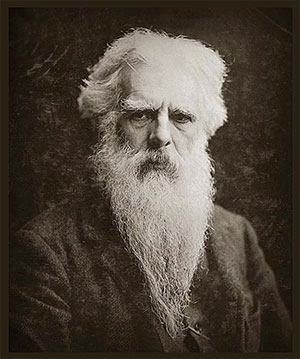
Eadweard Muybridge
Photo Courtesy Wikipedia Commons |
Which is why the story of three dozen photographs, taken 150 years ago in the recently purchased territory, is interesting. The man who took the photos would go onto become one of history's most famous photographers and set the stage for the "moving pictures" that became movies and television.
But when he came to Alaska in 1868, Eadweard Muybridge was in the beginning of his photographic career.
Muybridge was born in 1830 in Kingston, England. His birth name was Edward James Muggeridge. But that was just the start. By the time he was an adult he had changed his last name to Muggridge. In his mid-20s he was calling himself Muygridge. At one point, after a trip to Central America, he was marketing his work under the name Eduardo Santiago Muybridge. In his 50s, he began spelling his first name Eadweard. Throughout his life, he signed his photos "Helios" after the Titan of the Sun.
When he died, in 1904, his gravestone carried the name Eadweard Maybridge, although that was probably a typo.
Raised in a family of stationers and corn merchants, Muybridge emigrated to the United States in 1850 and lived for several years in New York City. He moved to San Francisco in 1855 and began working as a publisher's agent and a bookseller.
Within five years, Muybridge had become a successful bookseller and own a prominent San Francisco business. Leaving his brother in charge of the store, he planned to sail back to the England to purchase a large number of antiquarian books to sell in his shop.
But Muybridge missed the ship sailing and made a fateful decision to travel overland to the East Coast instead. He left San Francisco in July of 1860 heading for St. Louis by stagecoach. In St. Louis he would board the train for New York where he would sail a ship to England.
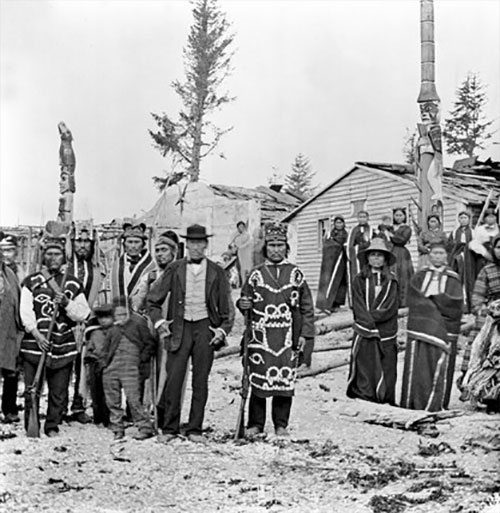
Tlingit village on Tongass Island, 1868-69, with natives wearing ceremonial blankets standing in front of houses and totems.
Photo By
Eadweard Muybridge c. 1868-1869
Courtesy Alaska State Library - Historical Collections |
Unfortunately, in Texas, Muybridge was severely injured in a stagecoach accident. A runaway team caused the coach to crash, injuring all the passengers and causing one fatality. Muybridge was ejected during the crash and struck his head on a rock. He was taken to a hospital in Fort Smith, Arkansas and remained there for three months. He then went to New York City where he would continue to convalesce for a year - suffering double vision, confused thinking, impaired sense of taste and smell and other problems - before doctors deemed him well enough to head on to England.
Muybridge continued to recuperate in England and as part of his treatment took up photography as well as print making. By the time he was ready to return to San Francisco in 1867, he had decided to make photography his career. He developed one of the first portable "darkrooms" – which he called his “Flying Studio” - to allow him to travel throughout the West, where he specialized in landscape photography as well as portraiture with his view camera and glass plate negatives. His early "stereographs" were very popular at San Francisco galleries and when he took some of the earliest photos of Yosemite in 1867, his fame began to spread East.
In 1868, Muybridge was hired by the US government to travel to Alaska to photograph the Tlingit Natives, the remaining Russian inhabitants and the dramatic scenery.
Late in July 1868, Muybridge boarded the steamship Pacific, in San Francisco, heading north to Alaska. The expedition was led by Major-General Henry Halleck, commander of the US Military Division of the Pacific. Halleck had served during the recent Civil War and at one point was appointed "General in Chief" of the Union Forces, but had proven not quite up to the task, at least according to President Lincoln. His skill set was more attuned to organization and less to battle, according to several biographers. After the war, he had been shunted West, then considered a military backwater.
When Alaska was purchased from Russia there was no civil authority to take to control, so Halleck was tasked with setting up a military government for the area.
On August 13, the Pacific crossed Dixon Entrance into Alaska and stopped at Tongass Island, where the Army was already constructing a fort. Muybridge had been specifically commissioned to photograph installations and harbors, but he almost immediately decided to document the Native people he encountered.
At Tongass Island he made a stereoscope of Chief Andaa and other Native leaders, as well as several expedition members on a beach in front of the village with houses and totem poles in the background. Muybridge liked the photo so much that he had made into a "carte de visit" an early combination of a post card and a business card. According to Muybridge documentarian Marc Shaffer, Muybridge gave a copy to Chief Andaa with the inscription "To the brave and noble Chief of the Tongass with Helios' respect."
The expedition continued north to Wrangell, where another military base was under construction, and then on to the new US capital, Sitka. All told, Muybridge was in Alaska for about two weeks.
Naturally there were reporters along on the trip.
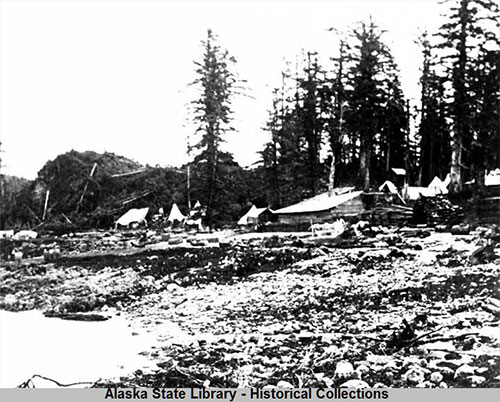
Fort Tongass Military Post; tents and wooden buildings along beach
Location: Tongass, Alaska
Photo By
Eadweard Muybridge c. 1868-1869
Courtesy Alaska State Library - Historical Collections |
"Helios had come to Sitka with dismal forebodings that the fog would so obscure the face of nature as to render his art valueless," a reporter would later note in the Daily Alta California newspaper. "But now he had struck a streak of sunshine and was determined to make pictures while it lasted."
The story noted that Muybridge trotted his "flying studio" through town and got "a number of excellent views." Overall, Muybridge returned from the expedition with 39 images. In Sitka, he captured more photos of the local Tlingits and of the Russian Orthodox priests who had remained in the community after the purchase. He also took several photos of the Sitka harbor from Japonski Island.
Although Muybridge was tasked with making photos for the military, Halleck - who was also an amateur historian - took a shine to Muybridge's images.
"These views, besides being beautiful works of art, give a more correct idea of Alaska, its scenery and vegetation, than can be obtained from any written description of that country," Halleck wrote in a letter to Muybridge just a couple of months after the expedition concluded.
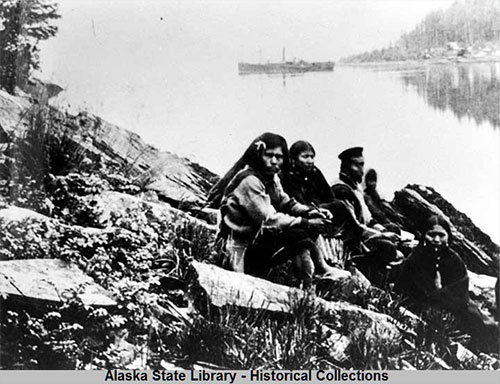
Fort Wrangell from Rock Cod; locals seated in foreground.
Photo By
Eadweard Muybridge c 1868-1869
Courtesy Alaska State Library - Historical Collections |
Although few in number, the photos taken by Muybridge in Alaska are considered the first commercial ones of the territory and its Native inhabitants. Muybridge went on to market his images across the country with the help of the US Government which wanted to counteract the concern that “Seward’s Icebox” was a frozen wasteland.
After returning from Alaska, Muybridge continued to photograph the West, In 1871, the Lighthouse Board hired him to photograph lighthouses along the West Coast. When the San Francisco Mint was built between 1870 and 1872, Muybridge made a series of images showing the progress. These photos would eventually be used as the earliest example of "time lapse" photography.
1872 would prove to be a pivotable year for the 42-year-old Muybridge. First, the former Governor of California Leland Stanford, one of the early railroad magnates, impressed by the photos of the Mint, hired Muybridge to help him settle a debate he was having with his fellow race-horse owners. The question was whether all four feet of a horse were off the ground at the same time while a horse was trotting or galloping.
Stanford's largesse allowed Muybridge near free rein in developing the elaborate technical equipment to create the photographs needed for Stanford to win his bet. Muybridge began experimenting with an array of 12 cameras set up to capture the individual steps of the horse. Muybridge also worked with Stanford’s railroad engineers to develop cameras with shutter speeds of up to 2000th of second, by far the fasted in the world at that time. This allowed for photographs that were faster than the eye could see.
It still took several years to perfect the process well enough prove the point that all four of the horse feet were indeed off the ground at the same time, therefore proving Stanford’s point.
At the same time, Muybridge developed a process using lantern slides to project the photos onto a screen, creating "moving pictures" when the slides were rapidly rotated.
In 1873, the US Army hired him to photograph the Modoc War, then taking place on the border of California and Oregon. Many of these photos were published across the country, further heightening Muybridge's fame.

Tlingit Natives standing in front of totems and buildings - Tongass.
Photo By
Eadweard Muybridge c. 1868-1869
Courtesy Alaska State Library - Historical Collections |
In 1872, Muybridge would also get married, a situation that would also dramatically increase his notoriety. He married the 21-year-old Flora Stone and in 1873, she gave birth to a son, Florado Helios Muybridge. But almost immediately, Eadweard Muybridge fell sway to rumors that the child was not his and that his young wife had a lover.
He determined that the lover was a newspaper drama critic named Major Harry Larkyns. In October, Muybridge went to Calistoga, and confronted Larkyns.
"Good evening, Major, my name is Muybridge," Muybridge said, according to testimony at the later trial. "Here's your answer to the letter you sent my wife."
Muybridge then shot Larkyns twice. Larkyns died several hours later. Muybridge was arrested and charged with murder.
He pleaded insanity, blaming the severe head injury he had suffered 14 years earlier. The jury – of 12 men - didn't buy the insanity defense but it acquitted him on the basis of "justifiable homicide."
The transcript from the trial itself would be used as the basis of an opera composed by American composer Philip Glass.
Flora would eventually divorce Muybridge and then die shortly after. Florado would end up in an orphanage, with Muybridge paying for his care but having nothing to do with him, despite the fact that photographs of the adult Florado showing a strong resemblance to Muybridge, according to Muybridge biographer Brian Clegg.
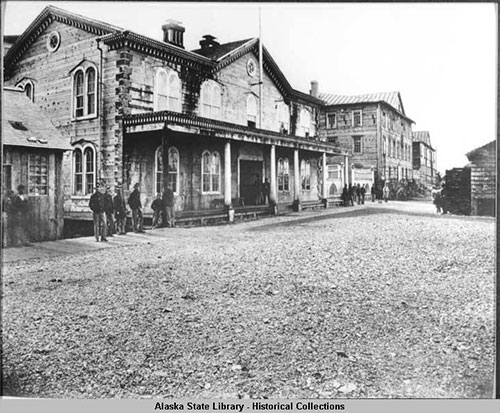
U.S. Army headquarters., Sitka, Alaska ca. 1868-69.
Photo By
Eadweard Muybridge c. 1868-1869
Courtesy Alaska State Library - Historical Collections |
Florado Helios Muybridge would spend most of his life as a ranch hand, before dying in Sacramento in 1944.
Meanwhile, Muybridge would continue his photographic motion studies, moving on from horses to other animals such as bison and finally people engaged in numerous physical activities. In the mid-1880s, working at the University of Pennsylvania, he made more than 100,000 images. He also developed a specialized projector called a zoopraxiscope.
In 1893, using the zoopraxiscope at the Chicago World's Columbian Exposition, Muybridge did a series of lectures on the "Science of Animal Locomotion" in a hall specifically for the showing of his "moving pictures. " Since Muybridge charged an admission fee, biographer Clegg notes it was the first commercial movie theater. Among the people who saw the exhibit was Thomas Edison. There were also several other viewers who would begin to develop the motion picture industry in the next few decades.
In 1894, Muybridge would return to England to spend the rest of his life. He published two popular books "Animals in Motion " (1899) and "The Human Figure in Motion" (1901) that remain in print today and are still used in biomechanics study as well as by contemporary artists.
Muybridge died from prostate cancer in May of 1904 in his home-town of Kingston.








